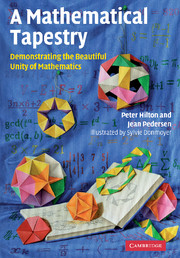Book contents
- Frontmatter
- Contents
- Preface
- Acknowledgments
- 1 Flexagons – A beginning thread
- 2 Another thread – 1-period paper-folding
- 3 More paper-folding threads – 2-period paper-folding
- 4 A number-theory thread – Folding numbers, a number trick, and some tidbits
- 5 The polyhedron thread – Building some polyhedra and defining a regular polyhedron
- 6 Constructing dipyramids and rotating rings from straight strips of triangles
- 7 Continuing the paper-folding and number-theory threads
- 8 A geometry and algebra thread – Constructing, and using, Jennifer's puzzle
- 9 A polyhedral geometry thread – Constructing braided Platonic solids and other woven polyhedra
- 10 Combinatorial and symmetry threads
- 11 Some golden threads – Constructing more dodecahedra
- 12 More combinatorial threads – Collapsoids
- 13 Group theory – The faces of the trihexaflexagon
- 14 Combinatorial and group-theoretical threads – Extended face planes of the Platonic solids
- 15 A historical thread – Involving the Euler characteristic, Descartes' total angular defect, and Pólya's dream
- 16 Tying some loose ends together – Symmetry, group theory, homologues, and the Pólya enumeration theorem
- 17 Returning to the number-theory thread – Generalized quasi-order and coach theorems
- References
- Index
1 - Flexagons – A beginning thread
Published online by Cambridge University Press: 10 November 2010
- Frontmatter
- Contents
- Preface
- Acknowledgments
- 1 Flexagons – A beginning thread
- 2 Another thread – 1-period paper-folding
- 3 More paper-folding threads – 2-period paper-folding
- 4 A number-theory thread – Folding numbers, a number trick, and some tidbits
- 5 The polyhedron thread – Building some polyhedra and defining a regular polyhedron
- 6 Constructing dipyramids and rotating rings from straight strips of triangles
- 7 Continuing the paper-folding and number-theory threads
- 8 A geometry and algebra thread – Constructing, and using, Jennifer's puzzle
- 9 A polyhedral geometry thread – Constructing braided Platonic solids and other woven polyhedra
- 10 Combinatorial and symmetry threads
- 11 Some golden threads – Constructing more dodecahedra
- 12 More combinatorial threads – Collapsoids
- 13 Group theory – The faces of the trihexaflexagon
- 14 Combinatorial and group-theoretical threads – Extended face planes of the Platonic solids
- 15 A historical thread – Involving the Euler characteristic, Descartes' total angular defect, and Pólya's dream
- 16 Tying some loose ends together – Symmetry, group theory, homologues, and the Pólya enumeration theorem
- 17 Returning to the number-theory thread – Generalized quasi-order and coach theorems
- References
- Index
Summary
Four scientists at play
In 1939 four young men were thrown together in graduate school at Princeton. They came from diverse backgrounds and went on to have very different careers. But for a short while all of them played with straight strips of paper made into what became known as “flexagons.” The thread that runs through this story is that of four creative young men who played for a while with an intriguing toy and then went on to other creative ventures in mathematics, physics, statistics, and computer science. We present here a small bit from each of their life stories.
In 1939 Arthur H. Stone (1916–2000), then a newly transplanted Englishman, was beginning his PhD work with Solomon Lefschetz at Princeton. According to Paul M. Cohn's obituary of Stone,
Arthur Harold Stone … was one of the foremost general topologists of his time, and made significant contributions to a number of different parts of general topology. … In 1927 [he] won a LCC scholarship to Christ's Hospital (Horsham). This was a boarding school which has had such successful pupils as Philip Hall, Christopher Zeeman (later Sir Christopher) and D. G. Northcott (Stone's contemporary). The mathematics teaching was in the hands of C. A. J. Trimble, himself a Wrangler. Here, Arthur won prizes in almost all subjects except sports (though he was also good at rugger [rugby football]). […]
- Type
- Chapter
- Information
- A Mathematical TapestryDemonstrating the Beautiful Unity of Mathematics, pp. 1 - 16Publisher: Cambridge University PressPrint publication year: 2010

